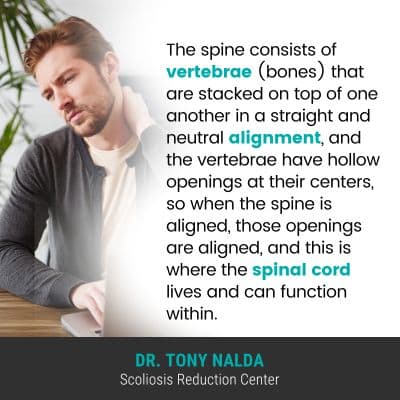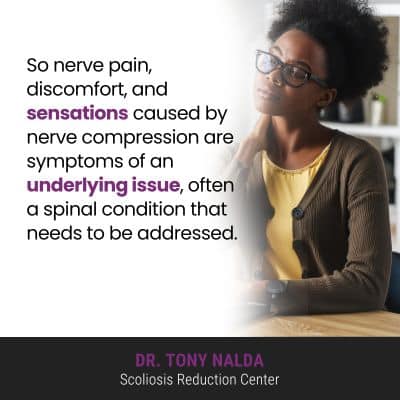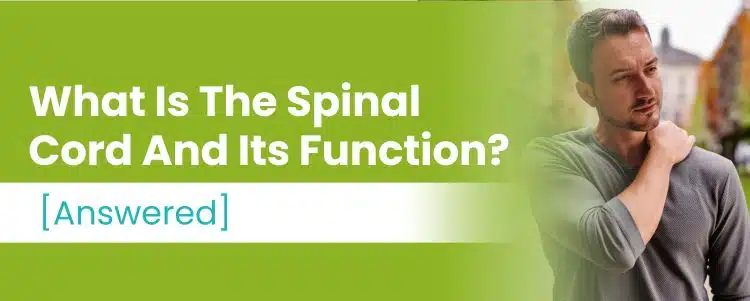The spine helps us to stand upright, practice good posture, move flexibly, and in addition, the spinal nerves within are involved in the function of virtually every part and system at work within the body. Because of the spine’s many important roles, spinal conditions can cause a number of symptoms felt throughout the body, and not just in the back.
The spinal cord is a bundle of nerves that runs through the spinal column, and the spinal cord and brain work in tandem to form the body’s central nervous system (CNS): a vast and complex communication network that facilitates brain-body communication.
To better understand the function of the spinal cord, let’s explore some basic spinal anatomy.
Anatomy of the Spine
The spine is important for a number of reasons; not only does it help us to move flexibly, it gives the body structure, protects important organs, and facilitates brain-body communication.
A healthy spine will have its natural curves and alignment in place; it will appear straight when viewed from the front and/or back and will resemble an ‘S’ shape when viewed from either side.
The spine’s natural and healthy curves make it stronger, more flexible, and better able to absorb and distribute mechanical stress incurred during activity, and there are a number of spinal conditions that involve a loss of its healthy curves, and if the spine loses a healthy curve, it’s replaced by a bad curve that disrupts the biomechanics of the entire spine.

The spine has three main sections, each with its own characteristic curvature type, and the health of each spinal curve is dependent on the health of the others.
The three main spinal sections are the cervical spine (neck), the thoracic spine (middle/upper back), and the lumbar spine (lower back), and each spinal section has its own roles to play in spinal health and function.
The cervical spine has to support the weight of the neck, the head, and facilitate the neck’s range of motion, and the thoracic spine is the largest section and the only one that attaches to the rib cage, and the lumbar spine has to support the weight of the spinal sections above, the trunk, and its vertebrae feel the effects of bending, lifting, and twisting motions.
The spine consists of vertebrae (bones) that are stacked on top of one another in a straight and neutral alignment, and the vertebrae have hollow openings at their center, so when the spine is aligned, those openings are aligned, and this is where the spinal cord lives and functions within.
Spinal Cord
The spinal cord consists of 31 pairs of spinal nerves, grouped in each of the spine’s main sections; specifically, there are 8 pairs of nerves in the cervical spine (C1 to C8), 12 pairs of thoracic nerves (T1 to T12, and 5 pairs of lumbar nerves (L1 to L5).
In addition, there is the sacral spine below the lumbar spine (triangular-shaped bone), containing 5 sacral nerves (S1 to S5), along with one coccygeal nerve pair.
The brain and spinal cord work together to form the body’s central nervous system, and the peripheral nervous system refers to everything outside of the brain and spinal cord that carries messages to the central nervous system.
It’s through the central nervous system that sensory information is received, processed, and responded to with motor signals.
If a nerve is pinched, compressed, impinged, inflamed, and/or irritated, where it’s located, and the type of nerve (motor, sensory) it is, will determine the type of symptoms experienced.
Spinal Cord Compression
There are a number of spinal conditions and spinal cord injuries that impact the health of the central nervous system, and in conditions that involve compression (uneven pressure), nerve roots can become irritated, inflamed, and/or impinged where they exit the spine, and symptoms can be felt anywhere along a nerve’s pathway, regardless of how extensive it is.
Nerve pain can be difficult to diagnose because it can be felt far from its site of origin; for example, in cases of lumbar scoliosis where the lower back develops an unnatural spinal curve and twist, as the sciatic nerve starts in the lumbar spine, if it bends and twists unnaturally, the nerve can be compressed causing pain felt in the lower back, hip, buttock, leg, and into the foot.
Someone experiencing foot pain is more likely to think the discomfort is related to an issue within the foot itself, and not because of a nerve that starts in the lower back; nerves are like branches on a tree, fanning off n different directions.
In cases of lumbar scoliosis, the unnatural spinal curve is introducing uneven forces to the spine, the spine’s surrounding muscles and nerves, and the entire body, and if the sciatic nerve is exposed to uneven pressure within the spinal cord, or where it exits the lumbar spine and extends into the lower body, it can cause a variety of symptoms felt throughout the lower body.
The sciatic nerve is a mixed nerve because it contains both motor and sensory fibers so has both motor and sensory functions that can be disrupted.
So what can be done if a spinal nerve is experiencing compression that’s disrupting its function?
Addressing Nerve Compression
Spinal nerve compression means a nerve within the spinal cord, or where it exits the spine, is experiencing uneven pressure, and this means it doesn’t have the space it needs to function optimally within; this is called nerve impingement, and conditions like scoliosis and stenosis can cause nerves to become pinched and irritated.
When scoliosis is the cause of nerve compression, and in adults, it’s nerve-pain that is the main symptom bringing them in for a diagnosis and treatment, the scoliosis has to be addressed as the underlying cause of the nerve compression.

So if the spine has an unnatural spinal curve that not only bends to the side unnaturally, but also twists, this is a structural issue within the spine itself, and if the nerves within are being affected, the underlying structural nature of the condition has to be addressed.
So nerve pain, discomfort, and sensations caused by nerve compression are symptoms of an underlying issue, often a spinal condition that needs to be addressed.
Stenosis occurs when there is a narrowing of space within the spinal canal, through which the spinal cord passes, and anywhere along the cord that has lost space means the nerve bundle within is being compressed, and this can disrupt their function and cause neuropathy.
So in cases where spinal stenosis is the cause of pinched nerves, treatment has to involve opening up space within the spinal canal and/or taking pressure off affected spinal nerves, and this can be worked towards through condition-specific chiropractic care that can address areas of vertebral subluxation and nerve compression.
Conclusion
The spinal cord is a bundle of nerve cell bodies that run through the spinal canal, which is a hollow tunnel formed by the spine’s vertebral column.
There are 31 pairs of spinal nerves that make up the spinal cord, and together with the brain, form the central nervous system.
As the central nervous system facilitates brain-body communication, it is involved in most bodily functions, sensations, and movements.
When nerve roots or nerves themselves are exposed to uneven pressure, pain can range from mild and intermittent to chronic and debilitating, and nerve pain can feel like sharp zapping pains, electric shock-like sensations, burning sensations, and/or muscle weakness.
When spinal conditions/issues such as scoliosis, spinal stenosis, or a spinal cord injury has caused nerve compression and/or damage, the underlying cause of the damage, the condition or injury itself, has to be addressed; nerve pain and discomfort are symptoms of a larger issue.
While some types of nerve compression and damage can be improved and/or reversed, the longer nerve compression is untreated, the more likely neuropathy is, and the more difficult it can be, if not impossible, to reverse the damage.
Here at the Scoliosis Reduction Center®, if a patient is experiencing unexplained nerve pain, the first step is determining the nerve pain’s underlying cause, and treatment plans are customized accordingly.




